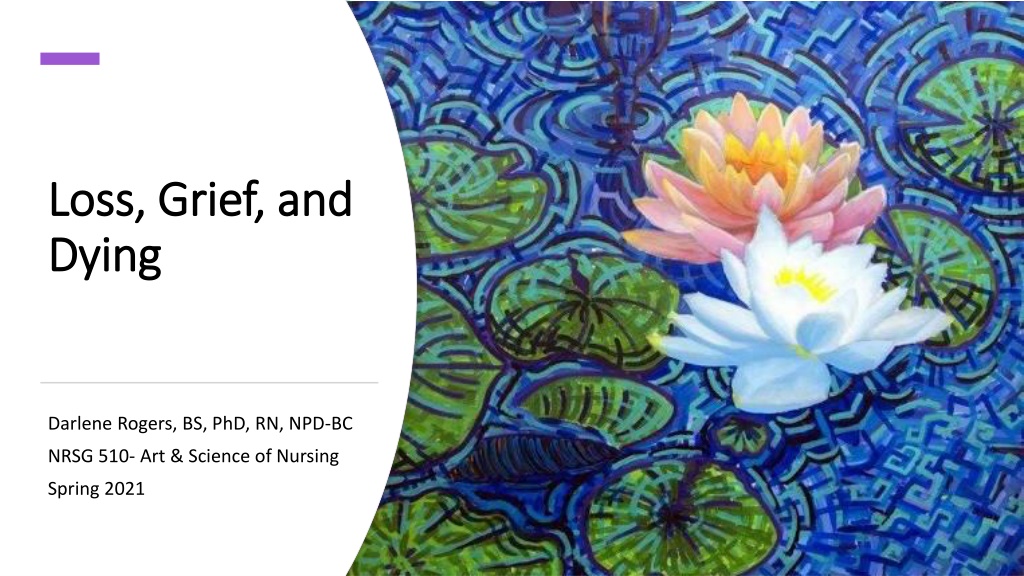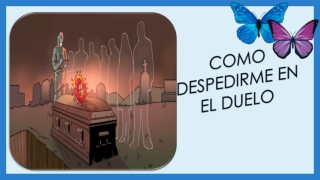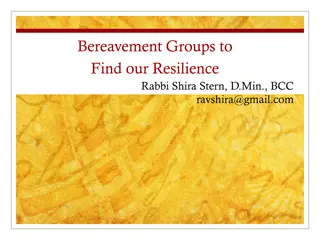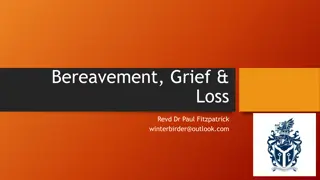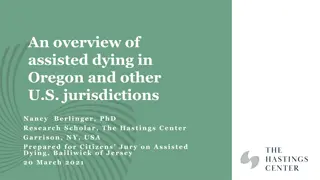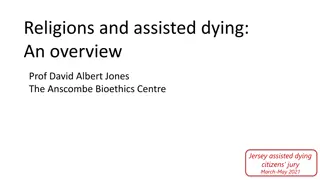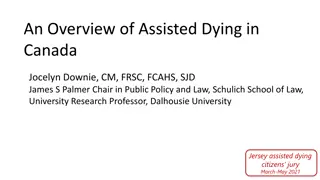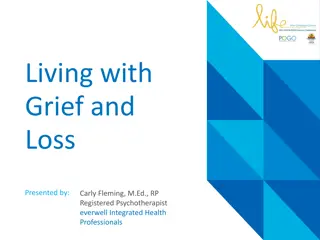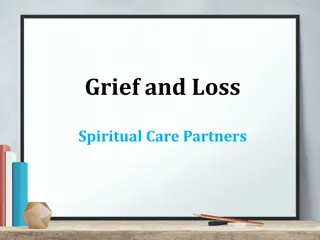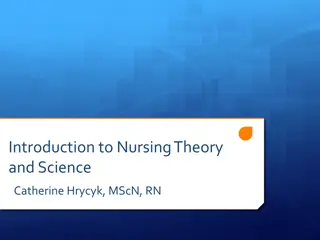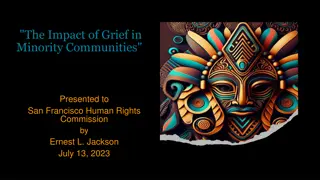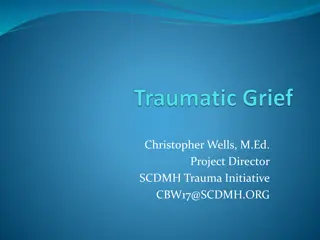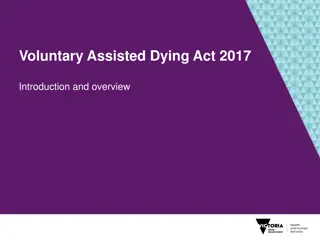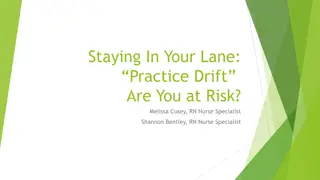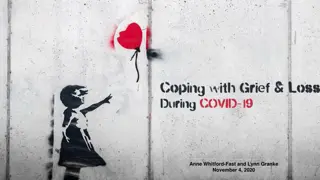Understanding Loss, Grief, and Dying: Insights for Nursing Practice
Delve into the concepts of loss, grief, and dying in healthcare settings. Explore different types of loss, the functions of grief, and nursing interventions for grieving or dying clients. Learn about the signs and symptoms of grief, and discover how to apply the nursing process to support clients and families through these challenging experiences.
Download Presentation

Please find below an Image/Link to download the presentation.
The content on the website is provided AS IS for your information and personal use only. It may not be sold, licensed, or shared on other websites without obtaining consent from the author. Download presentation by click this link. If you encounter any issues during the download, it is possible that the publisher has removed the file from their server.
E N D
Presentation Transcript
Loss, Grief, and Loss, Grief, and Dying Dying Darlene Rogers, BS, PhD, RN, NPD-BC NRSG 510- Art & Science of Nursing Spring 2021
Objectives Objectives 1.Explore the concept of loss among healthcare clients 2.Differentiate among respite, palliative, and hospice care 3.Recognize the physical and emotional signs of dying 4.Identify the normal functions of grief 5.Apply the nursing process to grieving clients and families 6.Identify appropriate nursing interventions for grieving or dying clients
Loss Loss The experience of parting with an object, person, belief, or relationship that one values. Loss requires a reorganization of one or more aspects of a person s life. Types of loss Material: Loss of a tangible object or possession. Psychological: Loss of something of important symbolic meaning. Expected: Loss occurring with forewarning. Unexpected: Loss occurring without warning. (Sellers, 2021, p. 1380)
Terms Related to Terms Related to Grief and Grieving Grief and Grieving Grief: Characteristic pattern of psychological and physiologic responses to the loss of a significant person, object, belief, or relationship Bereavement: State of desolation that occurs as the result of a loss, particularly the death of a significant other Mourning: Socially prescribed behaviors performed after the death of a significant other Anticipatory grief: Characteristic pattern of psychological and physiologic responses made to an impending loss (Sellers, 2021, pp. 1380-1381)
Function of Grief Function of Grief To make the outer reality of the loss into an internally accepted reality To alter the emotional attachment to the lost person or object To make it possible for the bereaved person to become attached to other people or objects (Sellers, 2021, pp. 1380-1381)
Models of Grieving Models of Grieving (Sellers, 2021, p. 1381)
What are Signs What are Signs and Symptoms of and Symptoms of Grief? Grief? Cognitive Emotional Physical Social
Factors Affecting Factors Affecting Grieving Grieving Meaning of the loss Circumstances of the loss Religious beliefs and loss Personal resources and stressors Sociocultural resources and stressors
Assessment and Risk Assessment and Risk Identification Identification The physical and psychological significance of the lost person or object Whether the loss was unexpected Whether the survivor contributed, or perceived that he or she contributed, to the loss Personal resources and stressors Sociocultural resources and stressors
Nursing Diagnosis & Outcomes Possible nursing diagnoses Anticipatory grieving Dysfunctional grieving Examples of patient outcomes Moving toward resolution of diverse emotions Accepting the reality of the loss Reinvesting emotional and physical energy in meaningful people and activities
Jim Jim Case Study Case Study A middle-aged man is admitted to your medical- surgical unit for assessment and treatment of coffee- ground emesis. During the admission assessment, Mr. Brown (who asks you to call him Jim) shares 1) he has been HIV+ for 14 years and 2) his partner of 15 years, John, died of complications from AIDS six months ago after numerous hospitalizations. Jim describes his abdominal pain like the pain John had before he died. Jim lives by himself now, has few close friends, and is estranged from his family. He occasionally becomes tearful during the examination. He stated I don t know what is wrong with me. I just can t get myself together and do things like I used to be able to do. (Sellers, 2021, p. 1388)
Jim Jim Case Study Case Study Is Jim grieving? What was his loss(es)? Is his grief dysfunctional? What factors are affecting his grief? What is the priority nursing diagnosis for Jim s situation? What are reasonable outcomes for Jim related to this diagnosis? (Sellers, 2021, p. 1379)
Jim Jim Nursing Diagnosis Nursing Diagnosis Risk for Complicated Grieving Related to death of a loved one As evidenced by (AEB) patient is tearful and states, I don t know what is wrong with me. I just can t get myself together and do things like I used to. (Sellers, 2021, p. 1379)
Dysfunctional Grieving Dysfunctional Grieving Dysfunctional grief: Grief that falls outside the normal response range and may be manifested as exaggerated grief, prolonged grief, or absence of grief; little time or energy is left to invest in normal growth and development. Complicated grief Manifestations of altered grieving Many symptoms are components of the normal grief process; the element of time after loss seems to be the defining factor in the diagnosis of dysfunctional.
Jim Jim Outcomes Outcomes Patient will be able to : Move toward resolution of diverse emotions Accept the reality of the loss Reinvest emotional and physical energy in meaningful people and activities (Sellers, 2021, p. 1379)
Health Promotion During Grief Health Promotion During Grief Patient & family teaching Assisting with working through the stages of grief Encouraging use of support groups (Sellers, 2021, p. 1388)
Jim Jim Nursing Interventions Nursing Interventions Health promotion teaching about the normal process of grieving and grief stages Assess for suicidal ideation Assess the patient s stage of grieving Encourage utilization of support groups Encourage utilization of professional counseling Individualized nurse-patient interaction Use careful communication and positive encouragement (Sellers, 2021, p. 1379)
Nursing Nursing Interventions Interventions for Stages in for Stages in Demi s Grief Demi s Grief Cycle Cycle Box 42 Box 42- -3 3 (Sellers, 2021, p. 1391)
Helping Parents Helping Parents Talk with Talk with Children about Children about Death Death (Sellers, 2021, p. 1391)
What would you say if a What would you say if a patient asks if they are patient asks if they are dying? dying?
Patient Outcomes in Patient Outcomes in Dying Dying Ultimate outcome: to achieve good end-of- life care and a good death Good death is defined by patients cultural and health beliefs: Includes an awareness, acceptance, and preparation for death by all concerned Includes control of physical and emotional pain and distress Bad death: Poor pain and distress management along with loss of independence and control (Sellers, 2021, p.1397)
Palliative Care and Hospice Palliative Care and Hospice Palliative Care: Improving the quality of life of patients and their families at any time during a life- threatening illness (cancer, kidney disease, heart disease, lung disease, dementia, AIDS, ALS, etc.) May be concurrent with curative treatment Multidisciplinary care team Whole person care emotional, social, practical, and spiritual Most insurance covers some palliative care (usually in-patient or otherwise limited) Hospice Programs: Supports people with limited life expectancy (< 6 months) Focus on relieving symptoms Comfort care, not curative care In-patient or at home Multidisciplinary care team Supporting patients and loved ones Loved one support extends after patient s death Covered by Medicare, Medicaid, and many private insurance programs (Sellers, 2021, p.1397)
Respite Care Respite Care People with chronic or debilitating illness may need 24-hour care Services for loved ones may include Bathing Dressing Eating, drinking, feeding Medications Exercise Group activities Outdoor activities Respite care provides a break for caregivers In home Day centers Special residential centers that offer overnight care Not typically covered by insurance; might have some coverage in long- term care policies, Medicare, or Medicaid Care givers feel guilty; do not always recognize they need a break
Definitions of Death Definitions of Death Uniform Determination of Death Act (1981) Irreversible cessation of all functions of circulatory and respiratory system, or Irreversible cessation of all functions of the brain Death has been defined as the irreversible cessation of: Heart lung function Whole-brain function Higher-brain function Medical criteria used to certify a death (2): Cessation of breathing No response to deep painful stimuli Lack of reflexes (gag or corneal) and lack of spontaneous movement Flat encephalogram (Sellers, 2021, p. 1395) (Taylor et al., 2019, p. 1688)
Signs of Impending Death Signs of Impending Death Difficulty talking or swallowing Nausea, flatus, abdominal distention Urinary or bowel incontinence or constipation Loss of movement, sensation, and reflexes Decreasing body temperature with cold, clammy skin Weak, slow, or irregular pulse Decreasing blood pressure Noisy, irregular, or Cheyne-Stokes respirations Restlessness or agitation Cooling, mottling, and cyanosis of extremities Be prepared to support family members through what they are seeing or hearing with their loved ones.
Advance Care Planning Advance Care Planning Advance Directives Living Will and/or Durable Power of Attorney for Health Care Legal documents Initiated by the patient Physician Order for Life-Sustaining Treatment (POLST) Medical orders specific to frail patients with highly advanced diseases (beyond standard care) Complement advance directives Written by health care provided based on patient s wishes This Photo by Unknown Author is licensed under CC BY-SA
Code Statuses Code Statuses Do Not Resuscitate (DNR) order No attempts (CPR, shocks, emergent cardiac medications, or intubation for ventilation) are made to resuscitate a patient whose breathing or heart stops Allow Natural Death (AND) order less intimidating terminology still stating no attempts should be made to resuscitate a patient whose breathing or heart stops Do Not Intubate (DNI) order chest compressions, cardiac medications, and shocks are acceptable but not intubation for ventilation
Euthanasia Euthanasia Euthanasia translates to good dying Active euthanasia taking steps to cause a patient s death Passive euthanasia withdrawing medical treatment with the intention of causing the patient s death Euthanasia is illegal in the United States but assisted suicide is legal in Washington D.C., California, Colorado, Oregon, Vermont, Maine, New Jersey, Hawaii, and Washington ANA position statement Nursing Code of Ethics prohibits nurses from participating in euthanasia; however, nurses must advocate for self- determination of patients; be aware of legal issues; and act on behalf of the patient to promote comfort and alleviate suffering but never to end life.
Nursing Diagnoses for Nursing Diagnoses for Dying Patient Dying Patient Pain Fatigue Deficient Fluid Volume Imbalanced Nutrition (less than body requirements) Impaired Gas Exchange Interrupted Family Process (Sellers, 2021, p. 1397) This Photo by Unknown Author is licensed under CC BY-SA-NC
Caring for the Dying Caring for the Dying Patient Patient Talk to patients and their families about dying, including the physical and emotional processes involved Help control pain Administer interventions for symptom control Appropriately use comfort care measures (Sellers, 2021, p. 1397) This Photo by Unknown Author is licensed under CC BY-SA
Post Mortem Care Post Mortem Care Place sign/indicator on patient room door, if hospital policy Maintain concern for the dignity in the care of the body and sensitivity to the needs of the deceased s family Religious and cultural customs should be observed as much as possible Family members may wish to spend time with the deceased Limit exposure to disturbing sight of equipment and medical supplies Remove unneeded items, clean, position, and cover the body of the deceased If autopsy is indicated (accidental or unexpected death), IV lines and other tubes should not be removed and should go to the morgue
Bodys Response Body s Response After Death After Death Pallor mortis (paleness) Algor mortis (temperature decrease) Rigor mortis (biochemical change in the muscles stiffen then soften; 2 to 18 hours) Livor mortis (hypostasis; blood pooling; starts 30 minutes after heart has stopped)
Post Mortem Post Mortem Care (continued) Care (continued) Body bag kit with tags and labels Nurse is legally responsible for placing an identification tag on the patient s big toe/ankle Place the deceased s body in the body bag Place dentures and glasses in the body bag (for mortician), unless family left other instructions Zip body bag and affix zippers with another ID tag Place other patient belongings in a separate bag with third ID tag. This bag should go to the patient s family When transporting the deceased in a body bag, cover the body bag with a sheet or blanket This Photo by Unknown Author is licensed under CC BY-NC-ND
Organ Donation Organ Donation Hospital notifies Organ Procurement Organization about potential donors If organ donation plans have not been established, Organ Procurement Organization representative obtains consent from authorized family member Organ donation is possible among consenting patients when irreversible brain death has been confirmed; tissue donation (skin, corneas, tendons, and bones) is possible from heart dead patients Donor s organs are maintained on artificial support until surgical staff is ready to recover organs, which remain viable for short period of time after removal from donor All incisions are closed so patient can have an open-casket funeral United Network for Organ Sharing (UNOS) manages national organ transplant system
The Pause The Pause Witnessing patient deaths can take a toll on nurses, who can become numb and burned out. Many hospitals have pause guidelines to encourage clinicians to have a 30- to 45- second reflective silence to honor the newly deceased. Any clinician can initial the pause; there is no script. Consult spiritual health or hospital staff chaplains to support clinicians after patient deaths. (Taylor et al., 2019, p. 1709)
References Sellers, C. R. (2021). Loss and grieving. In R. F. Craven, C. J. Hirnle, & C. M. Henshaw (Eds.) Fundamentals of nursing Concepts and competencies for practice (9th ed., pp. 1379- 1402). Wolters Kluwer. Taylor, C., Lynn, P., & Bartlett, J. (2019). Fundamentals of nursing. The art and science of person-centered care. Wolters Kluwer. This Photo by Unknown Author is licensed under CC BY-SA
